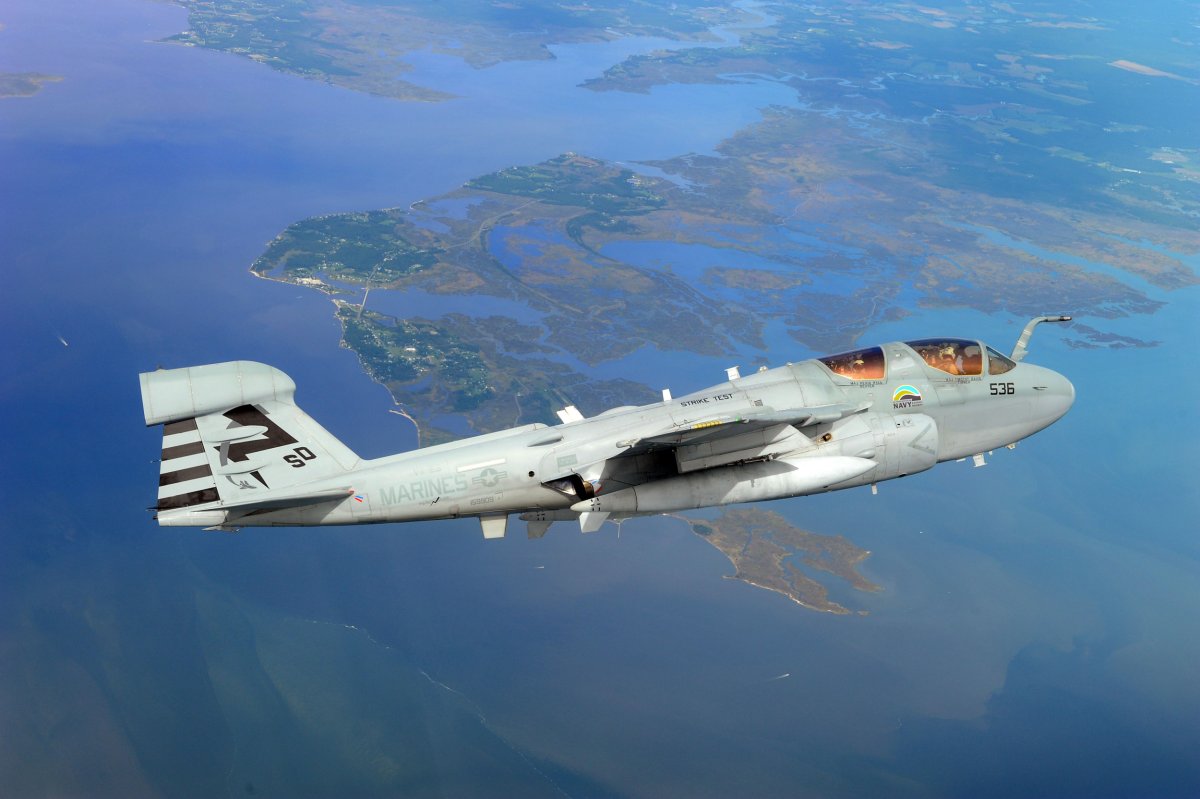The U.S. Navy is likely not the first organization to come to mind when you think about climate action and sustainability. But on the day after Earth Day, Assistant Secretary of the Navy for Energy, Installations and Environment Meredith Berger was decked out in eco-green for a series of events in Washington, D.C., to highlight the Navy’s work to prepare for climate-related risks and cut its own contributions to climate pollution.
“I’m the first chief sustainability officer of the department,” Berger told Newsweek. She said the job includes making sure the Navy’s coastal bases and installations will be sustainable as the effects of climate change become worse.
“If they cannot withstand the storms that we are seeing or the water intrusion from the sea level rise, then that is not a good investment,” she said. “We need to prioritize everything that considers these climate impacts.”
Mass Communication Specialist 2nd Class Greg Hall/Courtesy of U.S. Navy
The Defense Department has elevated climate change as a threat to be reckoned with. In the forward of the Navy’s Climate Action 2030 Strategy, Navy Secretary Carlos Del Toro called the climate threat to its bases “existential,” and said climate impacts can multiply risks Marines and sailors face.
Berger said that is already the case with some extreme weather events made more severe by climate change.
“You are seeing more incidents where the Navy, the Marine Corps is required to respond to allies, to partners, to emergency circumstances, for humanitarian assistance and disaster relief,” she said.
The Navy and other armed forces are, themselves, major contributors to the source of the problem.
In a 2019 report, the Costs of War project at Brown and Boston universities determined that the Department of Defense is the world’s largest institutional user of petroleum “and correspondingly, the single largest institutional producer of greenhouse gases in the world.”
The military accounts for only a small percentage of total U.S. emissions, but even that small portion is more than the total emissions from some industrialized countries, including Sweden and Portugal, the report’s authors said.
In short, the military has a massive carbon “boot” print, and work underway by the Navy could help cut those emissions.
“We are major contributors in terms of fuel consumption emissions,” Berger said. “So that makes us a market driver and a solution setter.”

Kelly Schindler/U.S. Navy via Getty Images
Clean Energy for War Fighters
Just beyond the main gates of the Naval Research Laboratory in Washington, D.C., a large bust of famed inventor Thomas Edison stares down from a towering stone column, a recognition of Edison’s role in bringing the lab about.
During World War I, Edison told The New York Times that technological advances would be vital to defense, and that the government should start a “great research laboratory.”
Navy leaders at the time took him up on the idea, and the lab was founded in 1923 along the Potomac River’s east bank in the southern-most section of Washington. For a century, the lab’s scientists and technicians have carried on in Edison’s innovative spirit, making important advances in radar and satellites and developing technology that allows the military to reach from the seabed to space.
More recently, many of the lab’s projects have aimed at moving and powering naval vessels, equipment and aircraft using alternative forms of energy. During a recent tour, lab scientists demonstrated experimental work in solar power, hydrogen fuel cells, batteries and other alternative fuel sources that hold the promise to carry and assist sailors and Marines where conventional fossil fuels cannot.
Hydrogen fuel cells have been adapted to power Marine expeditionary forces on the move and to fuel unmanned aerial vehicles, or drones. The lab and its corporate partners have developed an experimental drone that combines a fuel cell with a thin solar array along its wings to keep the craft aloft for days at a time, a much longer flight time than batteries would allow, researchers said.
Marines at Camp Lejeune in North Carolina have tested a fuel cell power pack they can carry into the field in a weatherproof case, allowing them to operate electrical equipment while in remote locations.
In a room at the lab equipped with large wave pools and sediment tanks, other researchers test ways to generate electricity and aviation fuel from one of a sailor’s most familiar surroundings: seawater.
A microbial fuel cell has been able to produce small amounts of electricity from organic matter around it in the water. It produces only a small amount of power, scientists said, but it could operate remote sensory and monitoring equipment at sea.
Nearby, another project on display at the lab pulls carbon dioxide and hydrogen from seawater. When combined, the result is a fuel that can be used in aircraft. The process requires quite a bit of electricity, but as researchers pointed out, that’s something many Navy vessels can produce in abundance thanks to their onboard nuclear reactors. The seawater-derived fuel could power aircraft in situations where the normal supply chain for fossil fuels could not.

Courtesy of U.S. Naval Research Laboratory
Sustainable Military Bases
The Navy has tried this kind of approach before. In the Obama administration, Navy Secretary Ray Mabus emphasized clean fuels research, and the Navy has had some success with biofuels and other substitutes for some ships and aircraft.
Navy and other military bases have also greatly expanded their renewable energy use, and Marine Corps Logistics Base Albany in Georgia is the country’s first net-zero energy military base, according to the Navy.
But the climate focus has met strong criticism from many in Congress. Some Republican lawmakers have warned that the current clean-energy shift is a potentially dangerous distraction from the military’s major objectives.
Berger said that even if those critics disagree with the environmental goals of climate action, they should consider the economic ones.
“I’m entrusted with the taxpayer dollars,” she said. “We want to make sure that we are investing soundly. That is a major concept of sustainability.”
She said she can’t ignore the long-term costs of climate impacts on Navy properties or the growing threat to Navy personnel.
“If we are sending them out into harm’s way and we understand that part of that harm is a climate threat, then we need to make sure we are anticipating how they will need to operate,” she said.
Uncommon Knowledge
Newsweek is committed to challenging conventional wisdom and finding connections in the search for common ground.
Newsweek is committed to challenging conventional wisdom and finding connections in the search for common ground.


